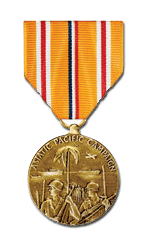
Establishing Authority
The Asiatic-Pacific Campaign Medal was established by Executive Order 9265 signed by President Franklin D. Roosevelt on November 6, 1942, and implemented by War Department Bulletin 56 (1942) and Navy Department General Orders Number 253 (1942).
Effective Dates
The Asiatic-Pacific Campaign Medal was awarded for qualifying service between December 7, 1941, and March 2, 1946.
Criteria
The Asiatic-Pacific Campaign Medal was awarded for for qualifying service within the Asiatic-Pacific Theater of Operations between December 7, 1941, and March 2, 1946, under any of the following conditions:
- On permanent assignment within the Asiatic-Pacific Theater; or,
- For service in a passenger status or on temporary duty for 30 consecutive days or 60 non-consecutive days; or,
- For service in active combat in the Asiatic-Pacific Theater of Operations against the enemy and awarded a combat decoration or furnished a certificate by the commanding general of a corps, higher unit, or independent force that the individual actually participated in combat.
ORDER OF PRECEDENCE
The Asiatic-Pacific Campaign Medal was worn after the American Campaign Medal and before the European-African-Middle Eastern Campaign Medal.
Devices
Bronze service stars:Bronze service stars were awarded by all services for participation in designated campaigns.
A bronze arrowhead device was awarded for participation in designated Army amphibious and airborne combat assaults (Note: only one bronze arrowhead could be worn on the ribbon).
Designers
The obverse of the Asiatic-Pacific Campaign Medal was designed by Thomas Hudson Jones (1892-1969). The reverse was designed by Adolph A. Weinman (1870-1952).
First Recipient
The first recipient of the Asiatic-Pacific Campaign Medal was General Douglas MacArthur, who was presented his medal on December 17, 1947.
Description and Symbolism
Obverse
In the center of a bronze medallion one and a quarter inches in diameter, the medal depicts a tropical landing scene with a battleship, aircraft carrier, submarine and aircraft in the background with landing troops and palm trees in the foreground. Above this scene, and following the contour of the medal, are the words ASIATIC-PACIFIC CAMPAIGN.
The invasion scene represents the numerous island operations of the war in the Pacific. The figures represent the Army (soldiers) and Marine Corps (Marines) while the ships in the background represent the Navy and the aircraft represent the Army Air Corps.
Reverse
In the center of a bronze medallion one and a quarter inches in diameter, an American bald eagle is shown alight on a rock. To the eagle's left, the dates 1941-1945 (in two lines); to the eagle's right, the words UNITED STATES OF AMERICA (in three lines).
The bald eagle is the national symbol and thereby represents the American people. It is perched on a solid rock which represents the firmness of resolve and strength of America in prosecuting the war, as indicated by the dates.
Ribbon
The ribbon to the Asiatic-Pacific Campaign medal consists of a yellow background bisected by blue, white and red pinstripes. Inside the outer edges of the ribbon there is another set of somewhat wider pinstripes, these being white, red, and white. The Secretary of War directed that ribbons for the area campaign medals were to employ Separate colors to denote the theaters they represented. The theater color was to predominate in each ribbon and the common relationship among all of them was to be achieved by using colored stripes put in the same place on each of the ribbons.
The predominant yellow in the background represents the sands of the islands in the Pacific, where many of the major engagements were fought; the blue, white and red pinstripes in the center are taken from the American Defense Service Medal and represent the national colors. The white-red-white stripes inside each edge of the ribbon are the colors of the empire of Japan and represent the enemy in the Pacific during the Second World War.